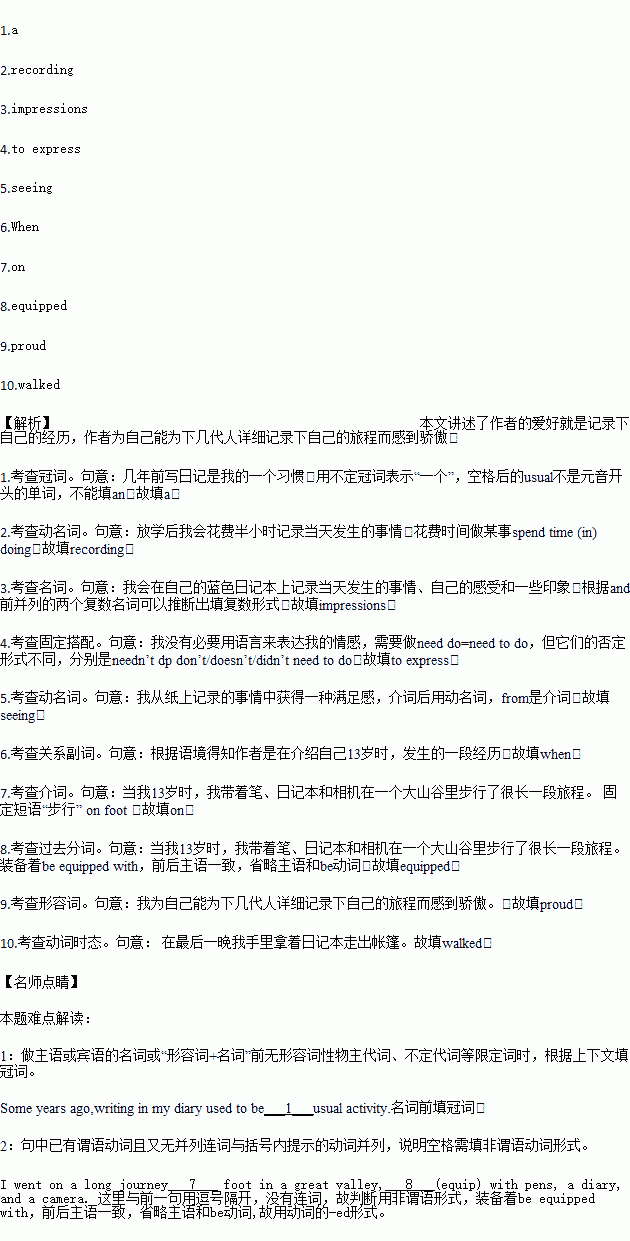题目内容
Some years ago,writing in my diary used to be1.usual activity. I would return from school and spend half an hour 2.(record)the day’s events, feelings, and 3.(impress)in my little blue diary. I did not really need 4.(express) my emotions by way of words, but I gained a certain satisfaction from 5.(see) my experiences forever recorded on paper, After all, isn’t accumulating(积累)memories a way of preserving the past?
6. I was thirteen years old, I went on a long journey7. foot in a great valley,8.(equip) with pens, a diary, and a camera. During the trip, I was busy recording every incident, name and place I came across. I felt 9.(pride) to be spending my time productively, dutifully preserving for future generations a detailed description of my travels. On my last night there, I 10.(walk)out of my tent, diary in hand.
 名校课堂系列答案
名校课堂系列答案Yellowstone Weather
Yellowstone National Park is at lofty height. Height. Most of the park is above2,275meters.
Yellowstone’s weather is unpredictable. In summer, it may be warm and sunny with temperatures in the high 70s. At night in any given month, the temperature may drop close to freezing. So it is best to come prepared for cold evenings and mornings,especially if you are camping or hiking. When you leave your campsite,please leave it prepared for possible thundershower and wind.
A sunny warm day may become fiercely stormy with wind, rain, sleet and sometimes snow. Without enough clothing, an easy day hike or boat trip can turn into a battle for survival.
Seasonal Weather Information | |
Spring Cold and snow continue into May, although temperatures gradually climb. Early in spring, daytime temperatures average in the 40s and 50s; by late May and June, they may reach the 60s and 70s, Nighttime lows fall below freezing. | Summer Daytime temperatures are usually in the 70s ,occasionally reaching the 80s in the lower elevations(高度). Nights are cool,temperatures may drop in the 40s and 30s―sometimes even the 20s. July and August tend to be somewhat drier, although afternoon thundershowers are common. |
Fall Weather can be pleasant, although temperatures average 10-2 degrees lower than summer readings, Nighttime lows can fall into teens and lower. Snowstorms increase in frequency as the weeks go by or towards the end of the fall season. | Winter Temperatures often stay near zero throughout the day, occasionally reaching high in the 20s. Subzero nighttime lows are common. Annual snowfall averages nearly 150 inches in most of the park. At higher places, 200-400 inches of snow have been recorded. |
1.If you are planning to stay here in spring for a few days, what is necessary for you?
A. Enough clothing. B. Weather report.
C. Umbrella. D. Boiled water.
2.Which season is generally pleasing?
A. Winter. B. Fall.
C. Spring. D. Summer.
3.In winter the average snowfall is_____.
A. 200inches B. 20inches
C. 150inches D. 400inches.
4.This passage is written probably for those who plan to______in Yellowstone National Park.
A. Do research work B. Take a business trip
C. Have sports games D. Spend their holidays or take a tour


 rrified D. Upset.
rrified D. Upset. n need is a friend indeed.
n need is a friend indeed.